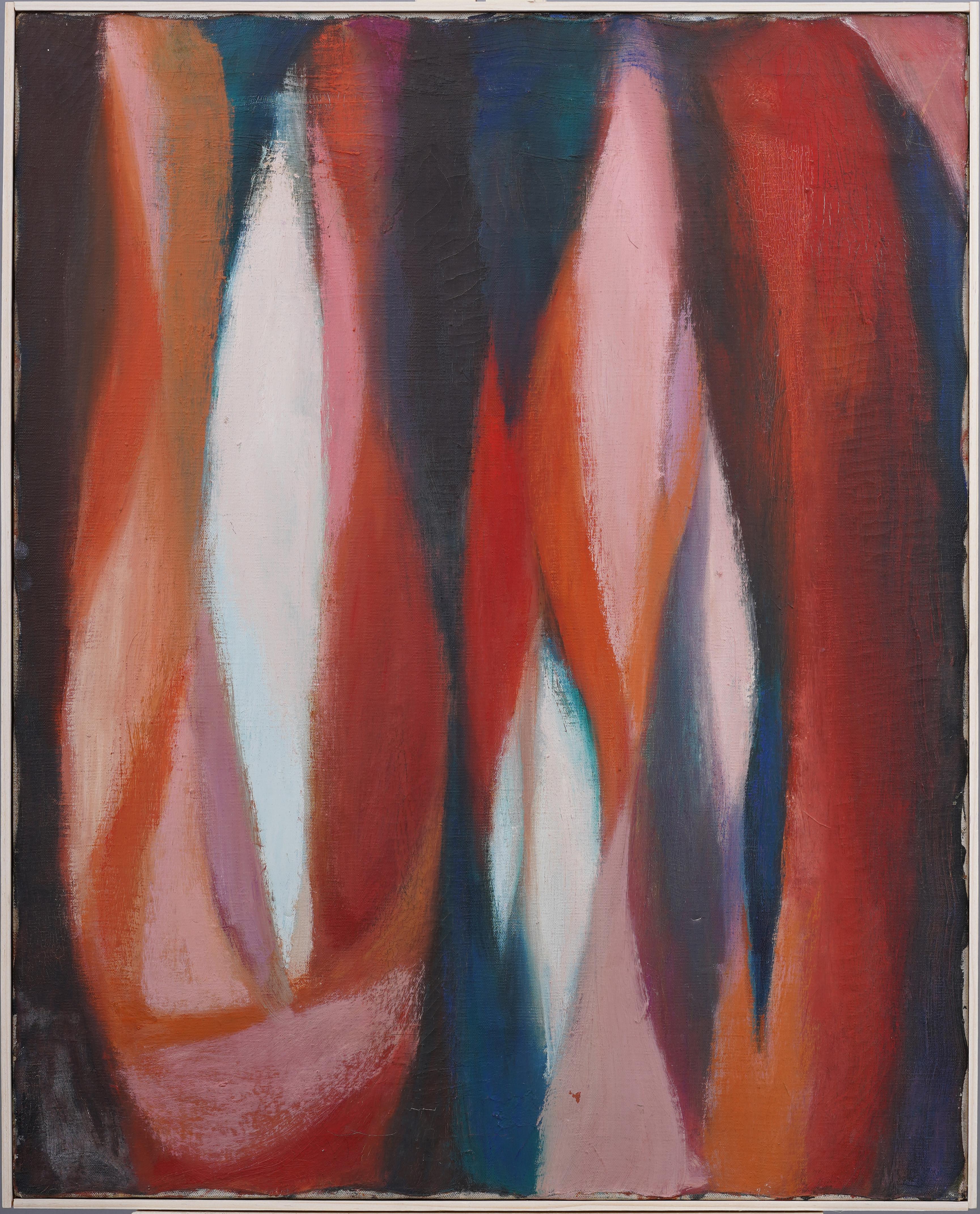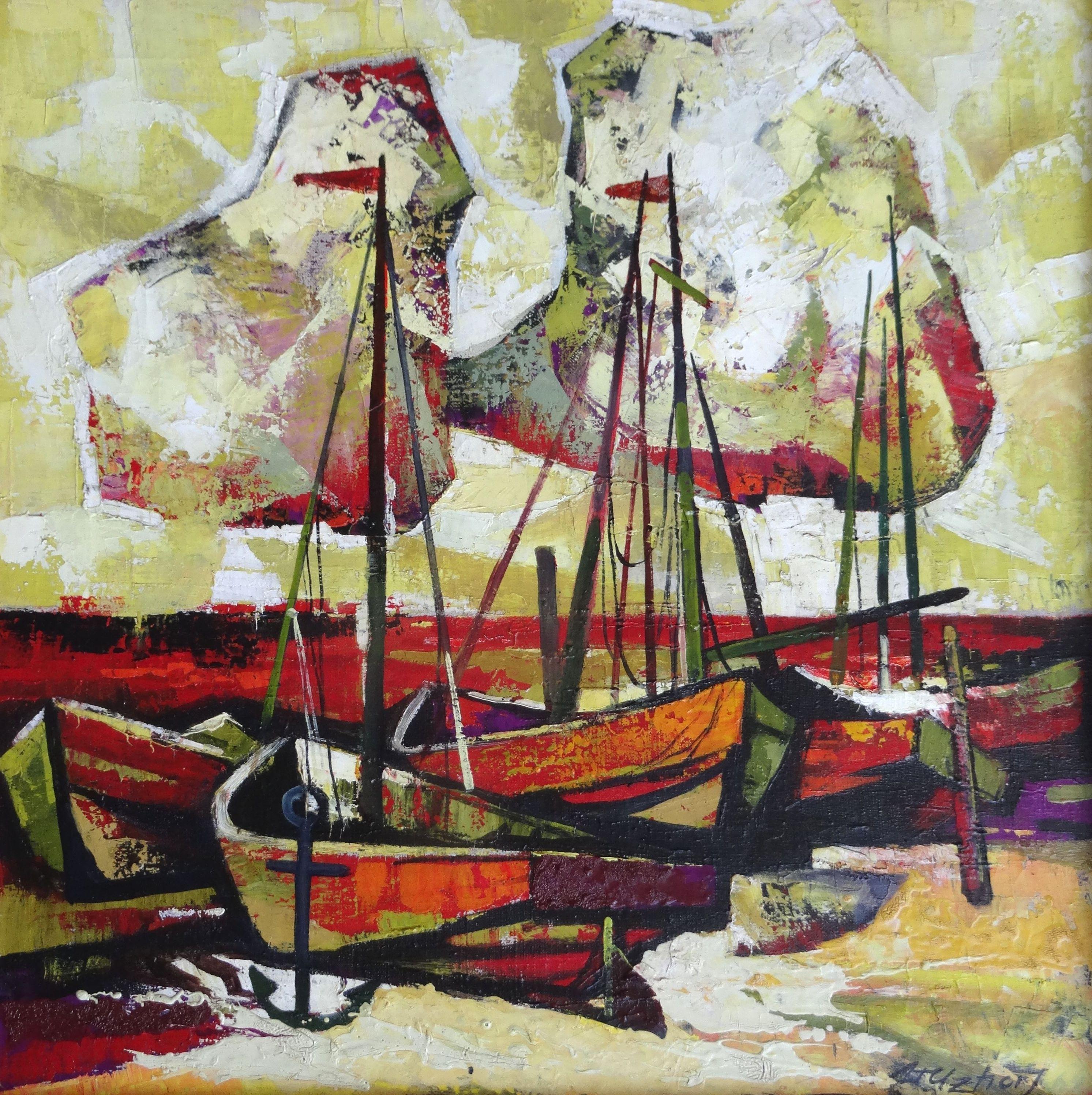Claude Venard"Venice Canal, Italy" Claude Venard, French Post-Cubist Mid-Century Moderncirca 1950-55
circa 1950-55
About the Item
- Creator:Claude Venard (1913-1999, French)
- Creation Year:circa 1950-55
- Dimensions:Height: 30.5 in (77.47 cm)Width: 30.5 in (77.47 cm)
- Medium:
- Movement & Style:
- Period:
- Condition:
- Gallery Location:New York, NY
- Reference Number:1stDibs: LU184129917692
Claude Venard
Claude Vénard has a distinct style — it’s post-Cubist in its composition and he progressively accentuated the chromaticism of his palette up to reaching the crudest of colors, which he used in very thick forms and sometimes applied with a pallet knife.
Vénard was born in France in 1913 and, dedicating himself fully to making paintings at the age of 17, he studied at the École des Arts Appliqués for six years, having fled the Académie des Beaux-Arts after just 48 hours. In 1938 he signed the Rupture manifesto and participated in the first exhibition of the influential group Forces Nouvelles, alongside Francis Gruber and Pierre Tal-Coat at the Galerie Billiet-Vorms. A close affinity subsequently developed among these painters and together they were instrumental in forging the aesthetic of the immediate postwar period of the Ecole de Paris.
Vénard quickly became known for his rich impasto and varying texture. He received critical acclaim and was personally championed by Andre Salmon and Waldemar George, who described his painting as “Apocalyptic art! Beings and everyday things suddenly regain their meaning. Emotional values are once more felt.”
Vénard’s distinct and alluring compositions developed through a post-Cubist system that oscillates between abstraction and naturalism. He opens up perspectives projecting spatial vistas into every part of the canvas, in accordance with an emotional rather than a physical order. Familiar objects arise in the midst of a network of striations and hatching. Colors grow more intense in certain zones to stress the solidity of the composition; in other zones the light is more tenuous and diaphanous, as if to indicate space of different emotional intensity.
Find original Claude Vénard paintings and prints on 1stDibs.
(Biography provided by Gallery of the Masters)
- ShippingRetrieving quote...Ships From: New York, NY
- Return PolicyA return for this item may be initiated within 3 days of delivery.
- "Tabac" Charles Green Shaw, Tobacco, Smoking, Park Ave Cubist, AAABy Charles Green ShawLocated in New York, NYCharles Green Shaw Tabac, circa 1935 Signed on the reverse Oil on canvasboard 5 3/4 x 8 3/4 inches Provenance: Washburn Gallery, New York, 1982 Private Collection (acquired from the above) Christie's, The Collector, October 20, 2021, Lot 307 Private Collection, Scarsdale, New York (acquired directly from the above) Literature: Hilton Kramer, "Charles Shaw: In the Minimal Tradition," New York Times, February 21, 1982, Section 2, p. 25. Charles Green Shaw was born in 1892 to a wealthy New York family. He lost both his parents at a very young age; his mother died when he was just three years old. Despite the early loss of his parents, Shaw lived the whimsical life of a New York socialite. As a beneficiary to an inheritance based in part upon the Woolworth fortune, he was brought up surrounded by the well-bred, well-groomed and well-moneyed citizens of New York’s elite social class. His social status as an adolescent was cultivated while spending summers in Newport and attending Christmas balls at Mrs. W.K. Vanderbilt’s. At age six, Shaw began to take an interest in drawing, and by nine, he was known to have a fondness for sketching historical costumes. After graduating from Yale University in 1914, Shaw spent a year studying at Columbia University’s School of Architecture. Subsequently he served for eighteen months as a Lieutenant in World War I. After his service, Shaw returned to New York and tried his hand as a businessman selling real estate, but his attempt was short lived. In the early 1920s, Shaw began his career as a journalist and novelist. He achieved professional success, writing consistently for magazines such as The New Yorker, Vanity Fair and The Smart Set. Shaw’s writing was a record of his approvals and disapprovals of the social crowd to which he belonged. His profession along with his social pedigree, brought him in contact with a number of the most significant figures of the 1920s such as, F. Scott Fitzgerald, Sinclair Lewis, George Gershwin, George Jean Nathan and the American artist George Luks. Some of his profiles included celebrity caricatures used as illustrations, these were the publics’ first look at Shaw’s artistic ability. In 1928, a collection of Shaw’s articles and interviews were published in one volume titled, The Low Down. Just previous to the stock market crash and the end of the Jazz Age, Shaw left New York and traveled to Paris and London. He arrived in Paris in 1929. In an autobiographical note Shaw suggests it was on this trip when he first began to paint seriously. London also acted as a great source of motivation for the budding artist. He began to sketch everyday in St. James’s Park, making large pastels of its vistas in the style of Cezanne. When he returned to New York in 1932, Shaw considered himself a painter. Success for Shaw came quickly with his first solo exhibition mounted at the Valentine Gallery in 1934. The following year Albert Eugene Gallatin included works by the artist in an unprecedented solo exhibition at his Gallery of Living Art at New York University. Shaw further cemented his reputation as an artist through his association and friendship with fellow abstract artists Morris and Gallatin. The trio soon was regarded as ‘the Park Avenue Cubists’. As a founding member of the American Abstract Artists, Shaw became an impassioned defender of the style. His 1938 essay in the American Abstract Artists yearbook, “A Word to the Objector”, acted as a defense against those who failed to see the illustrative quality of abstract art and scolded those who disregarded American artists as serious Abstractionists. He was also an influential force at the Museum of Modern Art, where he sat on the Advisory Board from 1936 to 1941. In the later years of Shaw’s life he continued to produce abstract paintings, yet in a more private manner. He was known to be a reserved man— a ‘gentleman’; not much is known about his personal life in these later years. During this time he maintained his career as a writer, publishing the well-known children’s book, It Looked Like Spilt Milk in 1940 and two books of poems in 1959 and 1962. In 1974, Shaw died...Category
1930s Cubist Landscape Paintings
MaterialsOil, Board
- "Virginia City, Nevada, " Joseph Cain, Mining Town, Silver Rush, Comstock LodeBy Jo CainLocated in New York, NYJoseph Cain Virginia City, Nevada Oil on masonite 21 5/8 x 36 1/2 inches Signed lower right A painter, muralist, and art educator, Joseph Cain's work was ...Category
Mid-20th Century Cubist Landscape Paintings
MaterialsOil, Masonite
- "Pastoral Landscape, " William Hart, Hudson River School, Cloudy View with CowsBy William HartLocated in New York, NYWilliam Hart (1823 - 1894) Pastoral Landscape, 1877 Oil on canvas 9 1/2 x 14 1/2 inches Signed and dated lower left Born in Paisley, Scotland, William Ha...Category
1870s Hudson River School Landscape Paintings
MaterialsCanvas, Oil
- "Other Side of Town (Leading to Pigeon Cove), " Anthony Thieme, Rockport Cape AnnBy Anthony ThiemeLocated in New York, NYAnthony Thieme (1888 - 1954) Other Side of Town (Leading to Pigeon Cove) Oil on canvas 30 x 36 inches Signed lower left Provenance: David H. Hall Fine Art, Dover, Massachusetts Vose Galleries, Boston, Massachusetts Private Collection, New Jersey Anthony Thieme was born in the Dutch port city of Rotterdam in 1888. He studied at the Academy of Fine Arts in Rotterdam, at the Royal Academy at the Hague, as an apprentice to George Hoecker, a well known stage designer in Düsseldorf, Germany, and to Antonio Mancini, an Italian Impressionist. After completing his studies, Thieme journeyed throughout Europe and South America, working in stage design to support his travels. Thieme first came to the United States in 1917 and initially worked as a set designer and book illustrator first in New York and later in Boston. By the late 1920s, Thieme had married and moved from Boston to Cape Ann in Rockport, Massachusetts, an emerging art colony. Like the other Rockport artists...Category
Early 20th Century American Impressionist Landscape Paintings
MaterialsCanvas, Oil
- "Portland Harbor, Maine, " Alexander Bower, Snowy River Scene in WinterBy Alexander BowerLocated in New York, NYAlexander Bower (1875 - 1952) Portland Harbor, Maine, 1910 Oil on canvas 27 x 33 inches Signed and dated lower right An American Impressionist, Alexande Bower was born in New York, studied at The Pennsylvania Academy of Fine Art, and was living with his wife in Cliff Island, Maine by 1914. Despite his urban upbringing, the coast and the sea fascinated Bower. A large portion of his paintings are seascapes, particularly scenes depicting the coast of Cape Elizabeth...Category
1910s Ashcan School Landscape Paintings
MaterialsCanvas, Oil
- "Gulls and Weir, " Philip Little, Coastal Landscape, New England ImpressionismBy Philip LittleLocated in New York, NYPhilip Little (1857 - 1942) Gulls and Weir Oil on canvas 30 x 30 inches Signed lower right; stamped on the reverse Provenance: Estate of William Postar,...Category
Early 20th Century American Impressionist Landscape Paintings
MaterialsCanvas, Oil
- Abstract Cityscape Cubist Oil on Canvas Painting by E. PullmanLocated in Atlanta, GAFrench artist E. Pullman (France, 20th Century) designed this stylish cubist abstract cityscape oil on canvas painting. The skillful composition and rigorous construction use vivid c...Category
Late 20th Century Cubist Landscape Paintings
MaterialsOil, Canvas
- Mid-Century Futuristic Cubist Cityscape.Located in Cotignac, FRMid-Century cubist oil and acrylic futuristic cityscape on canvas. Signed bottom right, artist unknown. Highly colourful and well-composed interpretation of a cityscape of the futur...Category
Mid-20th Century Cubist Landscape Paintings
MaterialsAcrylic, Oil, Canvas
- Valley landscape. 1962, oil on canvas, 65, 5x75, 3 cmLocated in Riga, LVValley landscape. 1962, oil on canvas, 65,5x75,3 cmCategory
1960s Cubist Landscape Paintings
MaterialsCanvas, Oil
- Signed Vintage American School Modernist Winter Cubist Framed Landscape PaintingLocated in Buffalo, NYFinely painted bright and brilliant cubist winter landscape. Framed nicely and signed lower right. Excellent mid century example.Category
1960s Cubist Abstract Paintings
MaterialsCanvas, Oil
- Antique American School Modernist Abstract Cubist Framed Mid Century PaintingLocated in Buffalo, NYNicely painted mid century abstract cubist oil painting. Great color and composition. Framed.Category
1950s Cubist Abstract Paintings
MaterialsCanvas, Oil
- Boats. 1980. Canvas, oil, 70x70 cmLocated in Riga, LVBoats. 1980. Canvas, oil, 70x70 cm Contrasting landscape with boats in cubistic style in red and yellow tonesCategory
1980s Cubist Landscape Paintings
MaterialsCanvas, Oil




